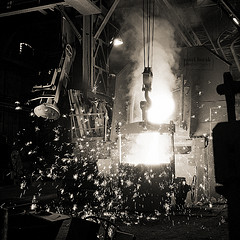Many Terms To Know For A Weapon
 Blade construction varied over the years based on the material and technology used. In the early years of metallurgy, blades were short. The length was limited by the material used until such time as smithing technologies improved to increase the tensile strength of the material. Bronze was first turned into blades due to the lower smelting temperature and produced a better blade. Iron was next, which although softer, had ore material that was more readily available and therefore used to outfit entire armies.
Blade construction varied over the years based on the material and technology used. In the early years of metallurgy, blades were short. The length was limited by the material used until such time as smithing technologies improved to increase the tensile strength of the material. Bronze was first turned into blades due to the lower smelting temperature and produced a better blade. Iron was next, which although softer, had ore material that was more readily available and therefore used to outfit entire armies.
Later the construction of the blade was altered yet further by introducing 'fullers'. The 'fuller' was a ridge that ran down the center of the blade. This left a groove like structure that eliminated metal material and therefore made the blade lighter, but was able to maintain its' strength, much like a steel I–beam used in construction.
The 'ricasso' was a short area of the blade immediately above the hilt on the blade side of the 'cross guard' which was not sharpened at all. This area was gripped by the finger for better tip control. Some blades did not have the 'ricasso'. In some other instances however, the 'ricasso' was large enough for a hand to fit around it and was therefore wrapped in leather. The purpose was to allow the other hand to be used to better manipulate the blade, especially dealing with large swords such as the enormous German Zweihänder.
The 'tang' is the part of the blade that extends into the hilt under the grip. This is also the part of the blade to mark the manufacturers' information. The 'tang' can be created as part of the blade, referred to as a 'full' tang. A 'full–tang' is preferable and was normally how blades were created anciently. This style of tang was necessary for durability in battle.
In some modern instances, to minimize manufacturing time and create a blade for display rather than actual use or authentic creation, a separate rod of steel or iron is welded to the blade and then the hilt is formed or fitted around it. This type of tang is referred to as the 'rat tailed' tang. This type of tang is structurally weaker and will most likely break off at the welding point if the Sword were to be put into action.
The curvature of the blade maintained an important feature of the sword. The curved radius of the blade was purposed to create a sawing effect on the battlefield, rather than simply delivering a heavy cut. By employing this feature the efficiency of the blade was improved and thereby reduced the amount of effort required to do the needed damage.
The curvature radius was altered and based on the country of origin. The middle eastern regions had a curvatures of radius closer to the hilt than those of their European counterparts, which accommodated the different battle techniques. The radius curvature was designed to be effective at the length that the warrior would use the weapon. So a longer curvature further away from the wielder, would be intended to be used at a longer distance.





Адрес заметки: http://metallurgytop.ru/post_1226226387.php
Рейтинг популярности - на эти заметки чаще ссылаются:
- 43 Герой социалистического труда
- 42 Известный телеведущий целую неделю снимал о Южном Урале
- 41 Первый чугун на каменном угле
- 39 Механизация очистки горновых канав
- 38 Замена конвейерных лент
- 36 Отработка верхнего шлака
- 34 Безотходное производство чугуна
- 33 Металлургия России: всем выйти из кризиса Читать полностью:
- 33 Ремонты чугунных и шлаковых канав
- 33 Системы программного управления